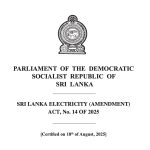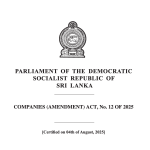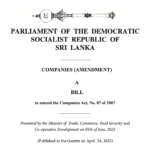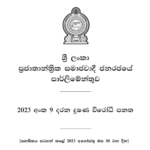This report provides a comprehensive analysis of SC Appeal No. 70/2018, Badde Liyanage Wasantha Kumara Fernando Vs Hon. Attorney General highlighting legal arguments, procedural nuances, and the broader implications of the judgment. The case revolves around sentencing for culpable homicide not amounting to murder under Section 297 of the Penal Code and the principles of fair trial, proportionality, and justice.
Case Background
Factual Summary
- Incident:
- The accused, Badde Liyanage Wasantha Kumara Fernando, was charged with causing the death of Anthonilage Pradeep Gamini Fernando in 2004.
- The offense arose from a confrontation during a drinking session, where the accused, provoked by his wife’s degrading remarks, attempted to attack the deceased with a bottle. After retrieving a knife from his residence, he fatally stabbed the deceased.
- Trial Proceedings:
- Initially charged under Section 296 (murder), the accused pleaded not guilty.
- During trial, he opted to plead guilty under Section 297 (culpable homicide) on grounds of grave and sudden provocation.
- The High Court imposed 15 years rigorous imprisonment and a fine of Rs. 7500/-.
- Court of Appeal Revision (2016):
- The sentence was reduced to 10 years rigorous imprisonment.
- Preliminary objections raised by the Attorney General regarding procedural propriety were not addressed in detail.
- Supreme Court Appeal (2020):
- The accused contended that the 10-year sentence was excessive considering mitigating factors such as:
- Passage of 13 years since the offense.
- Lack of premeditation.
- Personal circumstances (marital and familial responsibilities).
- The accused contended that the 10-year sentence was excessive considering mitigating factors such as:
Legal and Procedural Issues
1. Intent vs. Knowledge
- The distinction between culpable homicide with intent and with knowledge is critical in sentencing under Section 297:
- Intent: Demonstrated by deliberate actions, such as using a weapon and targeting vital areas.
- Knowledge: Actions likely to cause death but without a direct intent.
- Application in This Case:
- The accused’s act of retrieving a knife and stabbing the deceased, coupled with the severe nature of injuries (as confirmed by the Judicial Medical Officer), evidenced intent to cause harm.
- The Court rejected claims of intoxication as a mitigating factor, as no evidence showed that the accused was incapable of forming intent due to intoxication.
2. Provocation
- Provocation under Section 297 requires immediate and direct response to a provoking act.
- In this case, the verbal insults from the accused’s wife could be considered provocative. However, the deceased’s intervention (“isn’t he your husband?”) did not justify the fatal response.
- The accused’s deliberate act of leaving the scene, retrieving a weapon, and returning to attack indicates a lapse in immediacy, undermining the provocation defense.
3. Delay in Trial and Sentencing
- Judicial Precedents:
- Ananda v. Attorney General (1995): Significant trial delays can mitigate sentences.
- Attorney General v. Dewapriya Walgamage (1990): Imprisoning after long delays can be inappropriate depending on the circumstances.
- Supreme Court’s Position:
- The trial delays were attributed to procedural requirements, including changes in plea and trial scheduling.
- The Supreme Court emphasized that the delay did not cause prejudice to the accused, as the trial was concluded efficiently once commenced.
4. Procedural Irregularities in the Court of Appeal
- The Attorney General raised objections to the accused’s bypassing of the statutory right to appeal and invocation of revisionary jurisdiction.
- The Court of Appeal proceeded without addressing these objections, leading to criticism by the Supreme Court for lack of reasoning in its judgment.
5. Proportionality and Sentencing
- Principles of Sentencing:
- Sentences must reflect the gravity of the offense, the offender’s intent, and societal interests.
- Mitigating and aggravating factors must be balanced.
- Analysis:
- The trial court’s 15-year sentence fell within the statutory maximum of 20 years for culpable homicide with intent.
- The Court of Appeal reduced the sentence to 10 years without providing sufficient justification beyond general references to mitigating factors.
- The Supreme Court upheld the reduced sentence but criticized the lack of detailed reasoning.
Key Judgments Referenced
- Ananda v. Attorney General (1995):
- Delays in trial can mitigate sentences, but each case requires a fact-specific analysis.
- Dhananjoy Chatterjee v. State of West Bengal (1994):
- Sentencing must consider public abhorrence for the crime and serve as a deterrent while balancing victim and societal rights.
- Attorney General v. H.N. de Silva (57 NLR 121):
- Judges must weigh the offense’s gravity, public deterrence, and the offender’s circumstances when determining sentences.
Supreme Court’s Judgment
- Conviction and Sentence:
- Affirmed the 10-year rigorous imprisonment imposed by the Court of Appeal.
- Directed the High Court to implement the sentence from the date the accused surrenders or his bail expires.
- Reasoning:
- The severity of the offense justified a significant sentence, considering the intent demonstrated.
- Procedural and evidentiary claims by the accused, such as intoxication, were deemed invalid.
Broader Implications
1. Sentencing Policy
- This case underscores the judiciary’s obligation to balance proportional punishment with mitigating factors, ensuring justice for both victims and offenders.
2. Procedural Clarity
- The Supreme Court’s critique of the Court of Appeal highlights the need for detailed reasoning in appellate decisions, especially when altering sentences.
3. Fair Trial Rights
- Delays in criminal trials remain a critical issue. While procedural delays did not significantly prejudice the accused in this case, the judiciary’s role in minimizing delays is vital for upholding fair trial standards.
Conclusion
The judgment in SC Appeal No. 70/2018 demonstrates a nuanced application of legal principles, balancing intent, provocation, procedural propriety, and societal interests. While the Supreme Court upheld the reduced sentence, its emphasis on detailed judicial reasoning and fair trial standards sets a precedent for future cases.
Download Full Judgement














